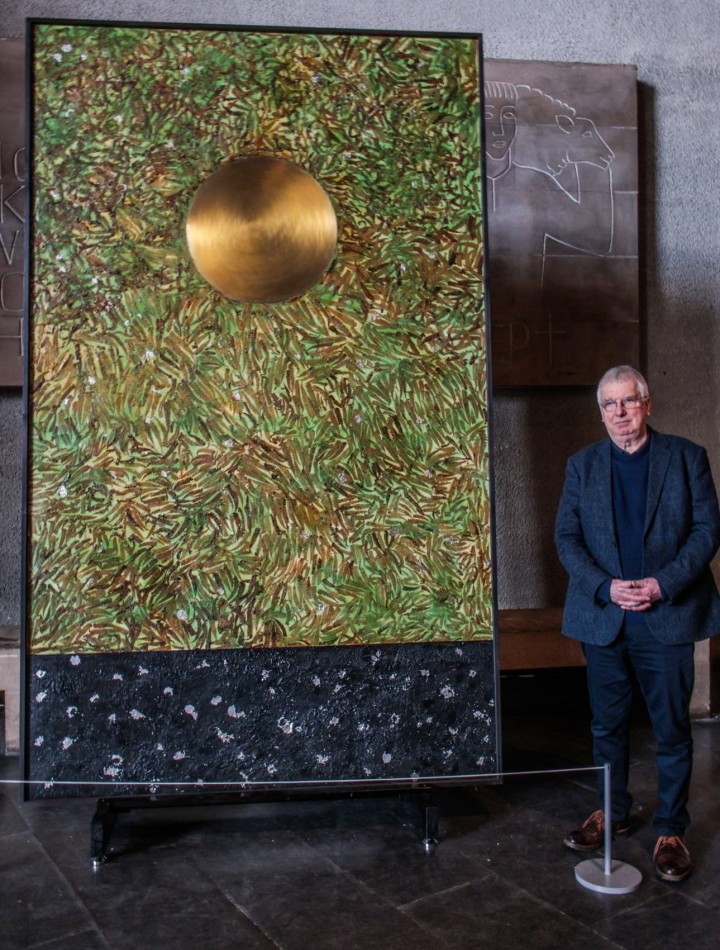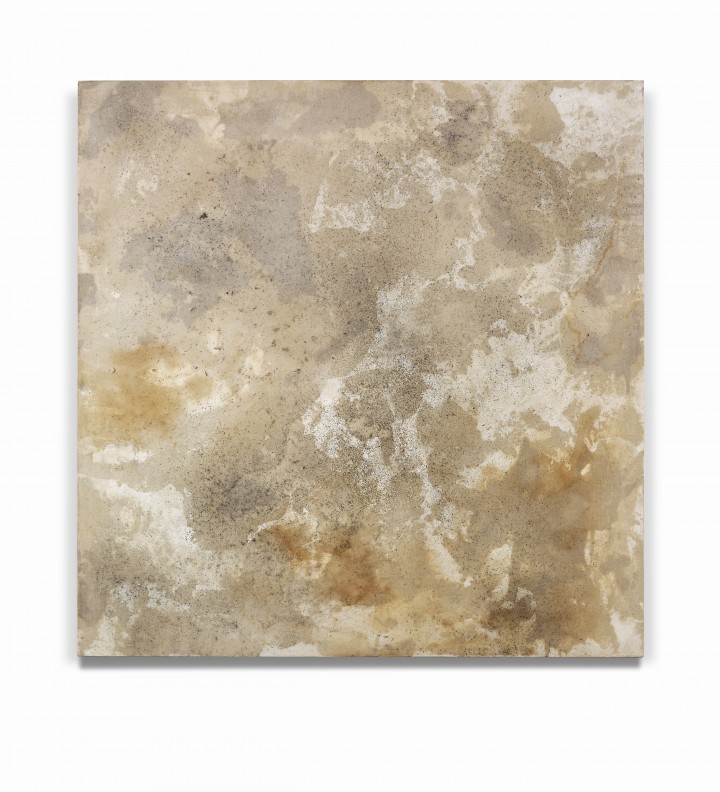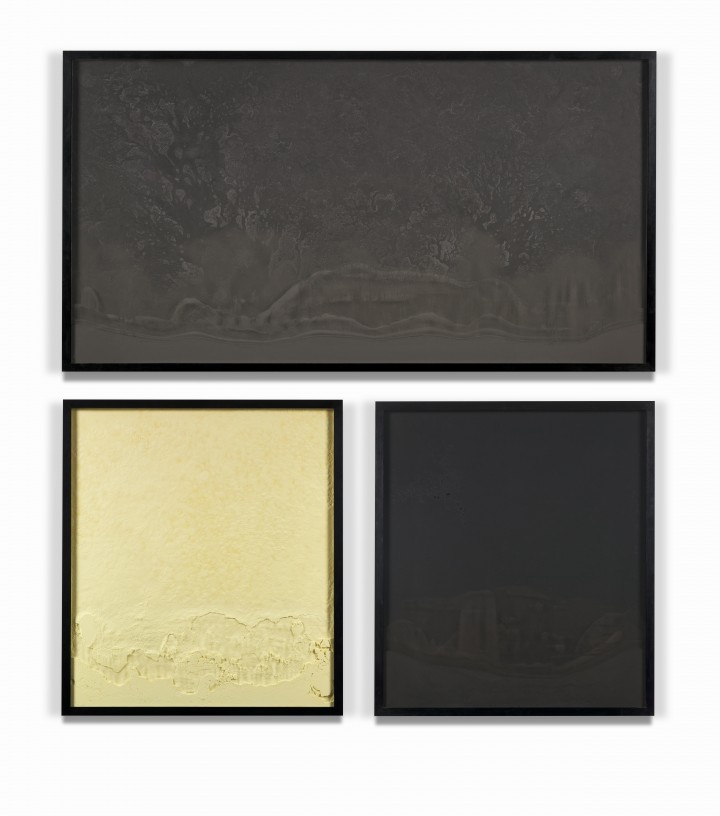Scottish Art News
Latest news
Magazine
News & Press
Publications
Science and Magic: Glen Onwin
By Greg Thomas, 26.05.2023

Science and Magic
Glen Onwin, whose work features in the current Fleming-Wyfold show This Fragile Earth at Coventry Cathedral, has spent a career turning chemical reactions and processes into art. As the Fleming- Wyfold Foundation announces a new acquisition of Onwin’s paintings, Greg Thomas puts his processes under the microscope.
Glen Onwin (b. 1947) trained as a painter but has spent most his career immersed in alchemy—that is, scientific processes imbued with a sense of primordial magic. The interest was first piqued in 1973, when the Edinburgh-born ECA graduate became engrossed by the salt marshes near Dunbar, on the East Coast of Scotland. His 1975 show Saltmarsh, at the Scottish Arts Council Gallery in Edinburgh, was inspired by that discovery, as recounted on a 1974 artist’s card:
Today I came across a spit of land, a joining of a river to the sea, brackish water, flooding salt resistant grassland, a near grid of circular pools not yet discovered by the constant rise, regular with undercut edges, some reflecting back the sky, solid underfoot, one easy leap from land to land, flooding, patterned oily water, mud, undrained, stagnant near the edge, alive, replenished twice daily, high pitched sounds, sea bird wader water, velvet blocks beneath the green of trees.
 Saltmarsh, 1974, mud and organic material on canvas, photo courtesy of the artist
Saltmarsh, 1974, mud and organic material on canvas, photo courtesy of the artist
We can note connections in the format of the Saltmarsh card to Richard Long or Hamish Fulton’s recorded walks, while Onwin’s sense that the mire might make a suitable subject, even material, for art, was inspired by the example of Robert Smithson’s ‘Spiral Jetty’ (1970). In this evocative description of a day of revelation, however, there is a clearer focus on the landscape alone, as apart from the experience of a body and mind moving through it, which distinguishes Onwin’s practice from that of his British peers, and from the sublime aesthetic spectacle of North-American land art.
Onwin’s breakthrough 1975 Saltmarsh exhibition expressed a quality of engrossment with the chemical processes that gave life to natural environments, a concern with the invisible truths of matter that was also a prescient ecological awareness. Much of the show comprised large-scale photography, emphasising the abstract patterning of curved land-lip and salt-pool. But there were also works made with the materials of the marsh itself, an approach comparable to arte povera aesthetics. These pieces were bound with wax, “a natural substance which prevents decay,” giving the works “a moist look, a richness of surface.” Of his process Onwin noted: “areas of mud and debris were built up and allowed to dry then wax applied. I scraped and sometimes chipped away areas of wax. The work is practically all chance. The work arrives.”
 Two Fold Trinity, Sulphur Carbon, 2016, Photo courtesy of the artist
Two Fold Trinity, Sulphur Carbon, 2016, Photo courtesy of the artist
Works arrived across the decades. Monumental projects were realised for an abandoned Methodist chapel in Halifax (‘As Above So Below’, Square Chapel, 1991) and the former Geevor Tin Mine in Cornwall (‘Blood of the Pelican’, part of the Tate St. Ives show A Quality of Light, 1997). Besides its scientific precocity, Onwin’s oeuvre has been consistently infused with a pagan sense of wonder at the elemental instability of natural substances: their capacity to dissolve, decay, reform, combine. The Square-Chapel project, supported by the Henry Moore Sculpture Trust, included a huge, squat and square vat of black brine. Clusters of salt crystals formed around islands of floating wax, composing themselves, as it were, according to chemical formulae. There was partly a kind of auto-destructive impulse at play here, slowed down to record the stately rhythms of non-human time. But the name of the work, ‘Nigredo – Laid to Waste’, indicated an equally significant concern with alchemy, a craft from that long era when science and magic were one. As Martin Kemp noted in a 1998 article, “Nigredo, is openly alchemical in its reference to the primitive and sometimes recurrent stage of black putrefaction in the transmutation of substances”—as if the crystalline matter were as significant in allegorical or spiritual terms as scientific ones.
It is also important to note that environmental awareness has been a consistent thread across Onwin’s career. A case in point is the major 1988 show Revenges of Nature, at Edinburgh’s Fruitmarket, which included paintings made with various bonded natural materials. One of these works, ‘Photosynthesis, Open the Kingdom’ (1987), appears in the Fleming-Wyfold’s current show alongside some of the Saltmarsh paintings and the more recent ‘Twofold Trinity, Sulphur-Carbon’ (2016-17). Given titles such as ‘Acidification’ and ‘Sea Dumping’, these pieces evoked the destruction of nature through scientific processes yoked to industrial extraction rather than reverent wonder. And it is this aspect of Onwin’s work that makes him not just a significant figure in the British land-art movement but an artist for the present moment, too.
Glen Onwin’s artworks acquired by the Fleming Collection are exhibited in A Fragile Earth at Coventry Cathedral until 29th May




